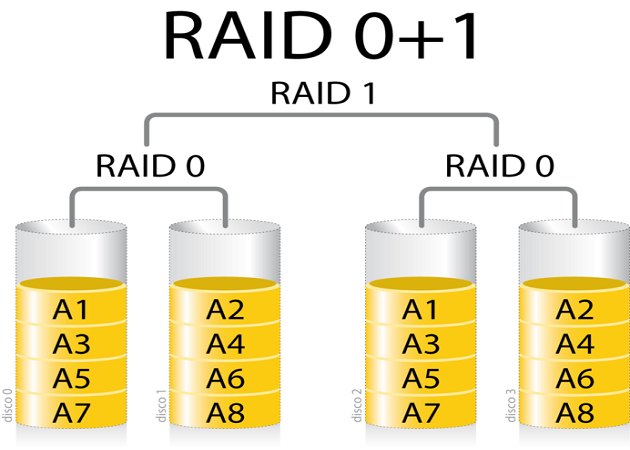What are RAID 1, RAID 1+0 and RAID 0+1

What are RAID 1, RAID 1+0 and RAID 0+1
What is RAID 1, RAID 1 + 0 and RAID 0 + 1
This is the second article in a series of our RAID. We hope to show - in the easiest possible way - What is RAID, and the idea of it and how it works. We wrote about RAID 0. Now is the time for RAID 1, RAID 0 + 1 and RAID 1 + 0.
What is RAID 1, RAID 1 + 0 and RAID 0 + 1RAID 1 (copies) - The basic idea of this solution is to repeat (copies) of two or more disks. This means that while the use of RAID 1, is created a replica (or mirror) on two or more disks. This solution gives a good read performance and reliability, but you should defragment storage capacity. The reason for this is that the total storage must be equal to the capacity of the smallest drive. Ie: in the case of a group consisting of 3 tablets - 250GM, 500GB and 1TB - will be usable space equal to 250 GB.
Why RAID 1
RAID 1 is the easy way to secure data and to maintain the reasonable value of reading, writing and access speed. Adoption of this strategy allows to maximize the full benefit of these processes. While it is sequential, and the speed of public writing is equal for all write operations from each drive in the array. It is a process at one time, and write operations take place in parallel with all of the drives - which means that the duration of the registration period is equal to the disk to run slower.
It is also possible to prepare this strategy to the process of reading. And can be serially - even reading speed can be almost equal to RAID 0 or it can only be done from the selected drives. The second solution is used when there are significant differences between the read speeds of each drive in the array.
But back to the Pros - The possibility to increase reading speed and reduce access time is the main advantage. The second is the integrity of the data. Wikipedia gives us a good and simple example:
Consider RAID 1 with two similar models of the drive with a 5% probability that the disk will fail within three years. Provided that the failure to be statistically independent, the probability of each of the disk failure during the three-year period is 0.25%. Thus, the possibility of losing all the data is 0.25% over a period of three years if nothing is done to the group. If the first disk failure is never replace, then there is a chance of 5% will be data loss. If only one of the disks fails, no data will be lost. As long as they failed disk is replaced by a second disk fails, the data safe.
However, since the two tablets are used identical and since the patterns used are also identical, their failure can not be assumed to be independent. Thus, the possibility of losing all the data, if not replace the first disk fails, you may be much higher than 5%.
In practice, a good management system in the above is irrelevant because it will not be hard to ignore the failed disk, but will be replaced. Is determined by the reliability of public order by the prospect of remaining engine will continue to work during the reform period, and this is the total time it takes to detect the failure, and the replacement of the hard drive failed, and that the campaign to rebuild. If, for example, it takes one hour to replace the failed drive is replaced, and the public knows the reliability of the system by the possibility of engine and the remaining disks operate for one hour without fail.
Source
It's also easy to see, and the possibility of data loss really small. This is the biggest advantage for RAID 1 - to allow for the issuance of a quick resolution to the rare possibility of data loss through disk failure.
However, there are also some drawbacks. As mentioned, a full range of storage capacity equal to the storage capacity of the smallest related disk. The second thing is something we can call and RAID 1 can prevent data loss due to disk failure, but in the virus or human factors case of "instant of writing and change the process." (Ie: accidental deletion of data) RAID 1 is useless. Changes at first will (two) in the disk array also take place in the second - immediately or soon. Will be the wrong one loss, malware or anything else and data.
What is RAID 0 + 1 and RAID 1 + 0
RAID 0 + 1 arrays means implemented in RAID 1, which is 0 RAID arrays elements. This implementation has speed RAID 0, RAID 1 safety benefits. It is also much easier to implement than RAID 3, RAID 5 or RAID 6. The main disadvantage of this solution is cost.
RAID 1 + 0
RAID 0 + 1
The implementation of RAID 1 + 0 set as RAID 0, who are RAID 1. It combines elements of the same advantages of RAID 0 (speed) and RAID 1 (safety), but in a different way. RAID 1 + 0 creates a large strip of small mirrors. After a disk failure, while being replaced, and the rebuilding of only a small part of a complete set. Unfortunately, it has the same drawback as that of RAID 0 + 1 - the cost of implementation.





















Post a Comment